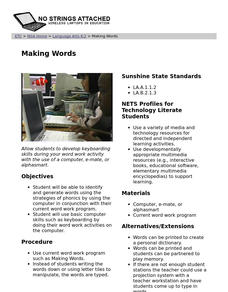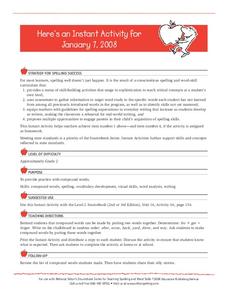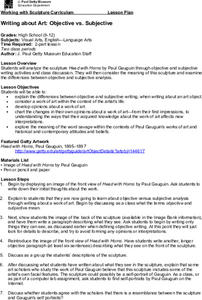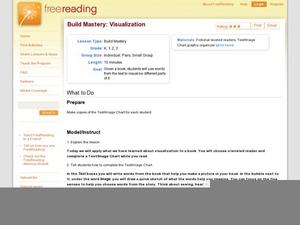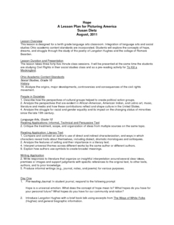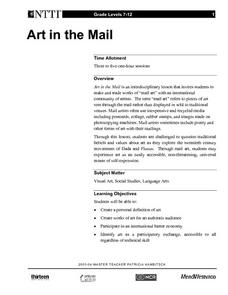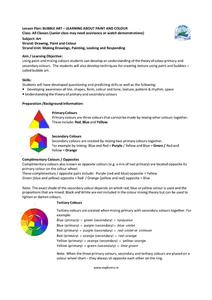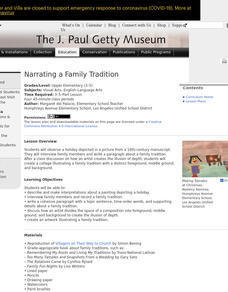Curated OER
The Power of the Image: Understanding Symbols in Buddhist Art
Students discuss symbolism in art, examine various images of compassion in Buddhist tradition, analyzing components of the concept, and then produce their own images of compassion through art.
Curated OER
Making Words
Young writers identify and generate words using the strategies of phonics on the Making Words computer program. Words are typed instead of having to use tiles or paper. Extension activities such as playing the memory game, drawing...
Curated OER
Compound Words
What's a compound word? Help your class understand the meaning of a compound word, and then give them the included worksheet to practice. To complete it, they write the two parts of a compound word and the new word formed in the spaces...
Curated OER
Word Art with King's Words
Students investigate equality and racism by creating a word art project. In this civil rights instructional activity, students discover the life of Martin Luther King Jr. and create a word art project using the Internet site Wordle...
Curated OER
Imagining China through Words
When Europeans first came back with tales of China, they provided vivid written accounts and minimal visual imput. This resulted in art rendered mostly from descriptive language. Learners explore this phenomena by listening to...
Curated OER
Should Art Be for Art's Sake?
Students examine how European-America aestheticians (philosophers of art) do not all agree about the value and definition of art. students examine how some cultures do not have a distinct word or definition for art.
Curated OER
Writing About Art: Subjective vs. Objective
Explore objective and subjective writing in this interdisciplinary instructional activity, which brings language arts and visual art together. Middle and high school learners examine the sculpture Head with Horns by Paul Gauguin. They...
Curated OER
Build Mastery: Visualization
What do you see? Young reader tap into the visualization process as they listen to or read a fiction story and fill out a graphic organizer. Model this first with a think-aloud, showing scholars how you visualize a familiar story. For...
Curated OER
Picturing America: Images and Words of Hope from Romare Bearden and Langston Hughes
A carefully crafted three-day lesson plan integrates poetry and visual art. By analyzing and comparing Langston Hughes' poem "Mother and Son" and Romare Bearden's collage "The Dove," readers explore the theme of hope. The lesson plan...
Novelinks
So Far from the Bamboo Grove: Visual Vocabulary and List-Group-Label
To make vocabulary words drawn from So Far from the Bamboo Grove memorable, class members select a word from the provided list and incorporate this word in a joke, story, or performance.
Curated OER
Art in the Mail
The "mail art" phenomena was started back in the 20's with the Dada and Fluxus art movements and revitalized in the 60's. The principle of mail art, is free exchange and artistic expression. Learners study these facts and then create...
Curated OER
Magic Words, Magic Brush: The Art of William Butler and Jack Yeats
Learners explore the influence of the landscape of Ireland on shaping the poetry of William Butler Yeats. They work in groups researching the growth of the Irish Nationalist Movement, Celtic origins, invasions, and the impact on the...
National Gallery of Canada
The Roots of My Family
Represent family history visually by requiring your young artists to create family trees that express balance and symmetry. Pupils examine works of art, research their family histories, and put together large family tree posters.
Curated OER
Pictures in Words: Poems of Tennyson and Noyes
Learners examine how Tennyson and Noyes use words to paint vivid pictures. They read and analyze two poems, complete an online scavenger hunt, complete a worksheet, and write examples of alliteration, personification, metaphor, simile,...
Curated OER
Juxtaposed Art
Learners draw on a memory to create a photographic art work. In this juxtaposed art lesson, students study the work of Dinh Q. Lé. Learners illustrate contrasting photos to conveys a specific purpose. Students learn to understand how...
Marine Institute
Bubble Art – Learning About Paint and Color
To gain an understanding of color mixing theory and the color wheel, young artists draw a picture, mix up a batch of secondary colors to which they add dish soap, and using straws, bubble up the paint. They then press their drawings onto...
Curated OER
Visualization: Cricket in Times Square
After reading The Cricket in Times Square chapter titled "Caught in the Kitchen," learners list three describing details about the characters and setting. Groups collaborate to find sensory details to support their character assertions....
National Gallery of Canada
One Look Is Worth A Thousand Words
Facial expressions can communicate complex emotions. Examine expressions in several hyperrealistic works of art before beginning a project. Learners will create their own clay faces that show an emotion using either photos or their own...
Curated OER
Red is the Word!
Through the use of stories, artwork, and the KidPix program, youngsters explore the color word red, and engage in activities around the word. Teaching kindergartners about the color words can be so much fun. This could be adapted for any...
Curated OER
Shoes and the Backyard Landscape
Your shoes get a lot of mileage in familiar places. Represent the places you have traveled the most with an art project based on a print of Indian People Wear Shoes and Socks by Juane Quick-to-See Smith. Kids trace their shoes and draw...
J. Paul Getty Trust
Narrating a Family Tradition
After examining a piece of art, scholars discuss what they see, paying close attention to details and space. A read-aloud introduces the topic of family traditions. Pupils interview their family members about a tradition in preparation...
Project Articulate
Textured Landscapes with Grant Wood
Explore the world of textured landscapes through the eyes of the famous artist, Grant Wood. Here is an elementary art lesson in which scholars learn about Grant Wood's life, view his work, draw their own textured landscape, and then...
Meadows Center for Preventing Educational Risk, University of Texas at Austin
Lesson 8 - Open Syllables
Just like scholars plug something in to close a circuit, they must plug a consonant onto a word to make closed syllables. Help learners distinguish between open and closed syllables with a series of activities that emphasize open...
EngageNY
Using Multimedia in Presentations: Preparing to Present Claims
Eye contact, volume, pronunciation are all parts of a great presentation. Scholars create visual displays to clarify the claim for an upcoming presentation about whether the American Academy of Pediatrics should increase its screen time...



